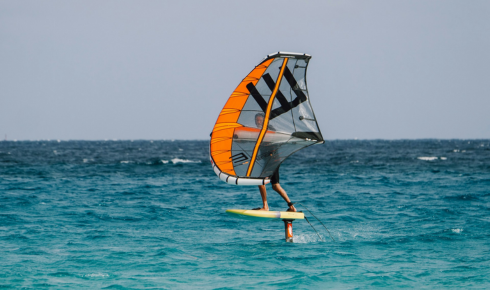How Technology Is Changing the Future of Watersports Foiling

Watersports have always existed at the intersection of nature and human ingenuity, from ancient paddle designs to the advent of fiberglass surfboards. Yet in recent years, no evolution has been more transformative—or visually striking—than the rise of foiling. Whether it’s surf foiling, kite foiling, or windfoiling, the sensation of “flying” above water rather than gliding across it is revolutionizing how athletes experience the ocean. At the heart of this revolution is technology: new materials, better hydrodynamic understanding, and a surge in design innovation. Foiling, once the domain of elite sailors and daring inventors, has become more accessible and thrilling thanks to these advancements.
Foiling works by using a hydrofoil—an underwater wing mounted beneath a board—to lift the rider above the surface. This significantly reduces drag and allows for smoother, faster, and more efficient rides. But the mere existence of hydrofoils isn’t new; they’ve been used in maritime vessels for over a century. What’s different today is the scale, performance, and application of foils in personal watersports. And that leap has everything to do with technology. Modern foils are crafted using carbon fiber composites that offer an ideal combination of strength and lightness. Designs are optimized using computer simulations, ensuring maximum lift with minimal resistance. As a result, athletes now have access to equipment that not only performs better but is also more durable and user-friendly.
Windfoiling and the Expansion of Possibilities
Take windfoiling, for example—a niche that’s quickly gaining popularity among windsurfing enthusiasts. Traditionally, windsurfing demanded strong winds and choppy waves to create excitement. Windfoiling, however, changes the game. By combining a windsurfing rig with a hydrofoil, riders can now take off in much lighter wind conditions, dramatically expanding where and when the sport can be enjoyed. This evolution has been possible only through sophisticated engineering in both sail design and foil construction. Today’s windfoil equipment often includes modular components that let users switch between foil sizes depending on the conditions, further increasing versatility.
The development of lighter and more responsive boards has also contributed to windfoiling’s growth. Designers are incorporating advanced shape profiling and load-distribution modeling into boards to make them more stable and easier to control while airborne. High-performance windfoil equipment may now feature carbon masts and fuselages, allowing for stiffer setups and more direct energy transfer from the rider to the foil. Innovations in rigging systems have made sails easier to handle, even for newcomers to the sport. This democratization of access is crucial—technology is not only enhancing elite performance but also opening the door for a new generation of casual water lovers to experience foiling.
Digital Tools and Real-Time Feedback
Another major leap forward in the foiling landscape is the integration of digital technology. Riders can now use GPS-tracking devices, smartwatches, and mobile apps to monitor performance metrics such as speed, glide time, elevation, and route. This data can be instrumental in fine-tuning technique, choosing the right gear for specific conditions, or simply sharing sessions with a community of enthusiasts. Some advanced windfoil equipment setups even feature sensors embedded in the foil or board, capable of providing real-time feedback about pitch angle, pressure points, and vibration levels.
These smart technologies are helping both amateur and professional foilers improve faster. Real-time analysis encourages experimentation and gives athletes a more analytical approach to their sessions. It also enables remote coaching, where experienced instructors can evaluate performance data and offer guidance, even when they’re not on the water. Combined with the rise of social media and content-sharing platforms, foiling is becoming a digital sport as much as a physical one—connected, competitive, and constantly evolving.
Environmental Considerations and Sustainability
As with any fast-growing sport, foiling must reckon with its environmental impact. The production of carbon fiber and composite materials is energy-intensive, and the global shipping of windfoil equipment contributes to emissions. However, technology is also playing a role in creating more sustainable practices. Manufacturers are increasingly exploring bio-resins, recyclable materials, and waste-reducing production techniques. Some brands are even developing trade-in and refurbishing programs to extend the lifespan of equipment.
Moreover, the reduced dependency on fossil fuel-powered watercraft in foiling—especially in wing and wind foiling—is a positive environmental development. Riders can cover long distances or enjoy exhilarating rides without engines or noise pollution. This makes foiling one of the most sustainable high-performance watersports available today. As technology advances, it will be vital for the industry to balance performance innovation with environmental responsibility, ensuring that the thrill of flight doesn’t come at the planet’s expense.
The Future of Foiling: Where Are We Headed?
Looking ahead, the future of watersports foiling is bright and rapidly expanding. Expect to see even more lightweight materials, integrated electronics, and AI-driven design tools shaping the next generation of gear. Virtual reality (VR) and augmented reality (AR) may eventually play a role in training and simulation, helping newcomers practice foil control and technique before hitting the water. Customizable components—adjustable foil wings, interchangeable masts, and digitally calibrated fins—could become standard, allowing riders to fine-tune their setups with unprecedented precision.
Windfoil equipment, in particular, is likely to benefit from ongoing aerodynamics research and improved sail design. The ability to ride with agility in a wider range of wind conditions is already a major selling point, and future innovations will likely further improve accessibility, efficiency, and safety. Whether you’re a weekend hobbyist or a seasoned competitor, the thrill of gliding silently above water is becoming more refined and more available. The boundaries between technology and nature are blurring, and foiling represents a compelling case of how innovation can elevate human experience—literally and metaphorically.
Frequently Asked Questions (FAQ)
What is windfoiling?Windfoiling is a water sport that combines traditional windsurfing with hydrofoil technology. A foil mounted under the board lifts the rider above the water, reducing drag and allowing for faster, smoother rides—even in lighter wind conditions.
Is windfoil equipment suitable for beginners?Yes, thanks to advancements in design and materials, many manufacturers now offer beginner-friendly windfoil equipment. These setups are more stable, easier to control, and require less wind to get started compared to older gear.
How does foiling compare to traditional surfing or windsurfing?Foiling offers a unique sensation of “flying” above water, which differs significantly from traditional board sports. It reduces surface resistance, enabling longer rides and a smoother feel, particularly in challenging or low-wind environments.
What are the key components of windfoil equipment?Windfoil gear typically includes a foil (with front and rear wings, mast, and fuselage), a specially designed board with a foil mount, and a sail rig. Some kits offer modularity for switching between different foil sizes or mast lengths.
Is foiling environmentally friendly?Foiling can be more eco-friendly than powered water sports, as it relies on wind or waves rather than fuel. However, the production of carbon fiber components has an environmental impact, which some manufacturers are addressing with more sustainable materials and practices.
Leave a Reply
You must be logged in to post a comment.




Leave a Comment